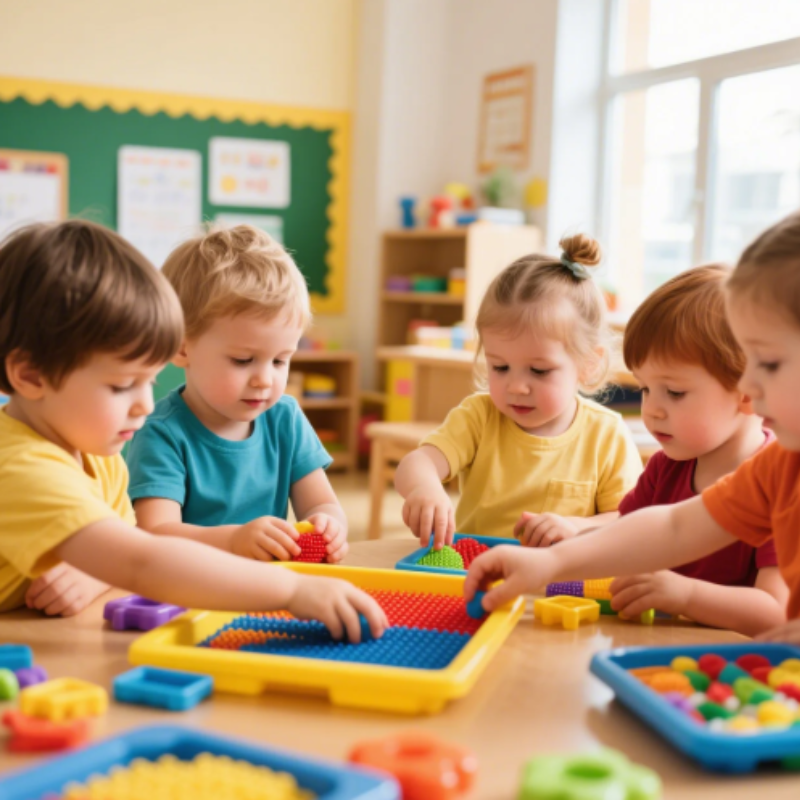As preschoolers grow, their brains are hard at work developing crucial skills that will serve as the foundation for their future learning and growth. Sensory activities—those that engage one or more of the five senses (sight, smell, taste, touch, and hearing)—play a significant role in this developmental process. These activities not only entertain but also provide valuable opportunities to enhance key cognitive, motor, emotional, and social skills.
Here’s how sensory activities help preschoolers build essential skills:
1. Cognitive Development: Sharpening Minds
Engaging in sensory activities is more than just fun—it stimulates the brain in profound ways, boosting cognitive development.
- Enhances Problem-Solving Skills: Sensory activities encourage exploration, experimentation, and trial-and-error learning. When preschoolers manipulate materials, such as squishing playdough or sorting different textures, they engage their problem-solving abilities. This helps them understand how things work, stimulating their curiosity and critical thinking.
- Supports Language Development: As children explore various sensory experiences, they learn new words related to their senses. Describing what they see, hear, feel, or smell broadens their vocabulary. Sensory play encourages children to express themselves more fully, whether they are identifying objects, discussing feelings, or narrating their actions.
- Stimulates Creativity: Open-ended sensory play, like building with sand or making patterns with watercolors, sparks creativity and imagination. By creating their own worlds with sensory materials, preschoolers develop their ability to think outside the box and become more inventive in their approaches to challenges.
2. Motor Skills Development: Strengthening Coordination
Motor skills are critical for preschoolers, and sensory play provides plenty of opportunities to improve both fine and gross motor skills.
- Fine Motor Skills: Sensory activities that involve manipulation—such as rolling playdough, using scissors, or picking up small objects—help preschoolers refine their hand-eye coordination and dexterity. These small movements, like pinching, grasping, and rolling, are essential for tasks like writing, buttoning clothes, or using utensils.
- Gross Motor Skills: Sensory play also incorporates physical activity that builds strength, balance, and coordination. Activities like hopping on a sensory path, jumping in puddles, or climbing on outdoor playground equipment help preschoolers develop their gross motor skills by using their large muscles.
- Improves Spatial Awareness: Through sensory activities, children learn to navigate their environment. Whether they’re stacking blocks, pouring water, or crawling through an obstacle course, preschoolers gain a better understanding of their space and how to interact with it.
3. Emotional and Social Skills: Growing Through Play
Beyond physical and cognitive development, sensory play fosters emotional regulation and social skills, providing preschoolers with important tools for interacting with others and managing their feelings.
- Promotes Emotional Regulation: Sensory activities help children become more aware of their emotions. For example, tactile experiences like squeezing a stress ball or feeling different textures can help calm down an anxious child. These activities teach children how to manage their emotional responses and self-soothe.
- Encourages Social Interaction: Many sensory activities can be done in groups, providing opportunities for preschoolers to engage with their peers. Whether they’re sharing materials, taking turns, or working together to build something, sensory play promotes collaboration, communication, and social skills.
- Builds Confidence and Independence: Completing a sensory task—whether it’s successfully stacking blocks, completing a puzzle, or experimenting with different colors—gives preschoolers a sense of accomplishment. This boosts their confidence and encourages independence, which is important for their self-esteem and emotional well-being.
4. Language and Communication Skills: Expressing Ideas
Sensory play also has a profound effect on language development, helping preschoolers learn how to express themselves and understand the world around them.
- Vocabulary Expansion: Every sensory experience introduces new words—whether it’s describing the texture of a material (smooth, rough), the sound of an object (loud, soft), or the sight of a color (red, yellow). This broadens a child’s vocabulary, which is essential for communication.
- Expressing Emotions: Sensory activities allow children to use language to express their feelings. For example, a child might say, “This playdough is squishy,” or “The water is cold.” Through these expressions, they not only describe the world but also begin to express how they feel about it.
- Following Instructions: Sensory play often involves activities where children need to listen and follow simple instructions. Whether it’s adding a certain color to a painting or placing items in a specific order, these activities help preschoolers improve their listening and comprehension skills.
Practical Examples of Sensory Activities
Incorporating sensory activities into your child’s routine doesn’t have to be difficult. Here are a few simple activities that can be done at home or in a preschool setting:
- Exploration with Natural Materials: Take a walk in the park or the backyard to collect natural materials like leaves, flowers, rocks, or pinecones. Let your child explore these materials with their hands and talk about the textures, shapes, and colors.
- Playdough and Clay Activities: Let your child mold, roll, squish, and shape playdough or clay. This not only enhances fine motor skills but also sparks creativity as they build objects or figures.
- Music and Sound Activities: Introduce musical instruments like tambourines, drums, or maracas. Listening to different sounds and making their own music helps children develop auditory skills and understanding of rhythm.
- Nature Walks and Exploration: A nature walk is a perfect opportunity for children to explore different textures, sounds, and sights. Collecting items like pinecones or sticks and observing the environment helps toddlers practice their observational skills.
Conclusion: Sensory Play as a Building Block for Development
Sensory activities provide preschoolers with more than just fun and entertainment—they’re an essential part of early childhood development. From enhancing motor coordination to building emotional intelligence, sensory play fosters a range of key skills that set the stage for lifelong learning. By incorporating sensory activities into your child’s daily routine, you’re giving them the tools they need to succeed and thrive in a world full of new experiences.
So, the next time you’re looking for an educational and engaging activity, turn to sensory play. It’s a simple yet powerful way to nurture your child’s growth while having a blast along the way!
What are your favorite sensory activities to do with your preschooler? Share your ideas in the comments below!





